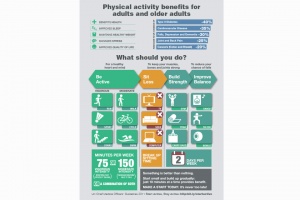Physical Activity Promotion in Your Clinic: Difference between revisions
Wendy Walker (talk | contribs) No edit summary |
Wendy Walker (talk | contribs) No edit summary |
||
| Line 20: | Line 20: | ||
Physical activity [PA] does not have to be strenuous to be effective. | Physical activity [PA] does not have to be strenuous to be effective. | ||
[[File: | [[File:PA infographic.jpg|thumb]] | ||
== Resources == | == Resources == | ||
Revision as of 00:21, 30 October 2017
Original Editor - Wendy Walker
Top Contributors - Wendy Walker, Kim Jackson, Tarina van der Stockt, Simisola Ajeyalemi, Rishika Babburu, Admin, Michelle Lee and Rucha Gadgil
Introduction[edit | edit source]
As physiotherapists we frequently provide patients who come into our clinic with advice on how to improve their physical condition, usually in relation to a specific health problem which for which they seek treatment: low back pain, plantafasciitis, etc. We expect to advise our patients on how best to treat their condition with exercise, and how to prevent recurrance, but do we also look at the larger picture, ie. the general fitness level of each individual?
Physical inactivity [PA] is the 4th leading cause of global mortality[1].
Advising an increase in Physical Activity - Why Bother?[edit | edit source]
Historically, physiotherapy interventions, ranging from electrotherapy, manipulation through to exercise recommendation, have been centred on the restoration of function lost as a result of either injury, or of a muskuloskeletal or neurological condition. In recent years physical inactivity has been shown to be one of the main risk factors for non-communicable diseases (NCDs), including cardiovascular disease, diabetes and cancer: see the page on Physical Activity and Non-Communicable Diseases for more information.
As therapists, we can influence the behaviour of people who walk into our clinic, and made them aware of the enormous benefits of physical activity; benefits to their health as well as to their mood and general well-being.
An alarming statistic: We are approximately 20% less active than people were in 1961. If this trend continues, by 2030 we will be 35% less active[2].
How much Physical Activity is enough to make a difference?[edit | edit source]
Physical activity [PA] does not have to be strenuous to be effective.
Resources[edit | edit source]
The Motivate2Move website, created by Wales Deanery, has a useful section on sedentary behaviour.
Add text here...
References[edit | edit source]
References will automatically be added here, see adding references tutorial.
- ↑ Lee I, Shiroma EJ, Lobelo F, Puska P, Blair SN, Katzmarzyk PT, for the Lancet Physical Activity Series Working Group. Effect of physical inactivity on major non-communicable diseases worldwide: An analysis of burden of disease and life expectancy. The Lancet. 2012;380(9838):219-229
- ↑ Ng SW, Popkin B (2012) Time Use and Physical Activity: a shift away from movement across the globe. Obesity Review 13(8):659-80.







